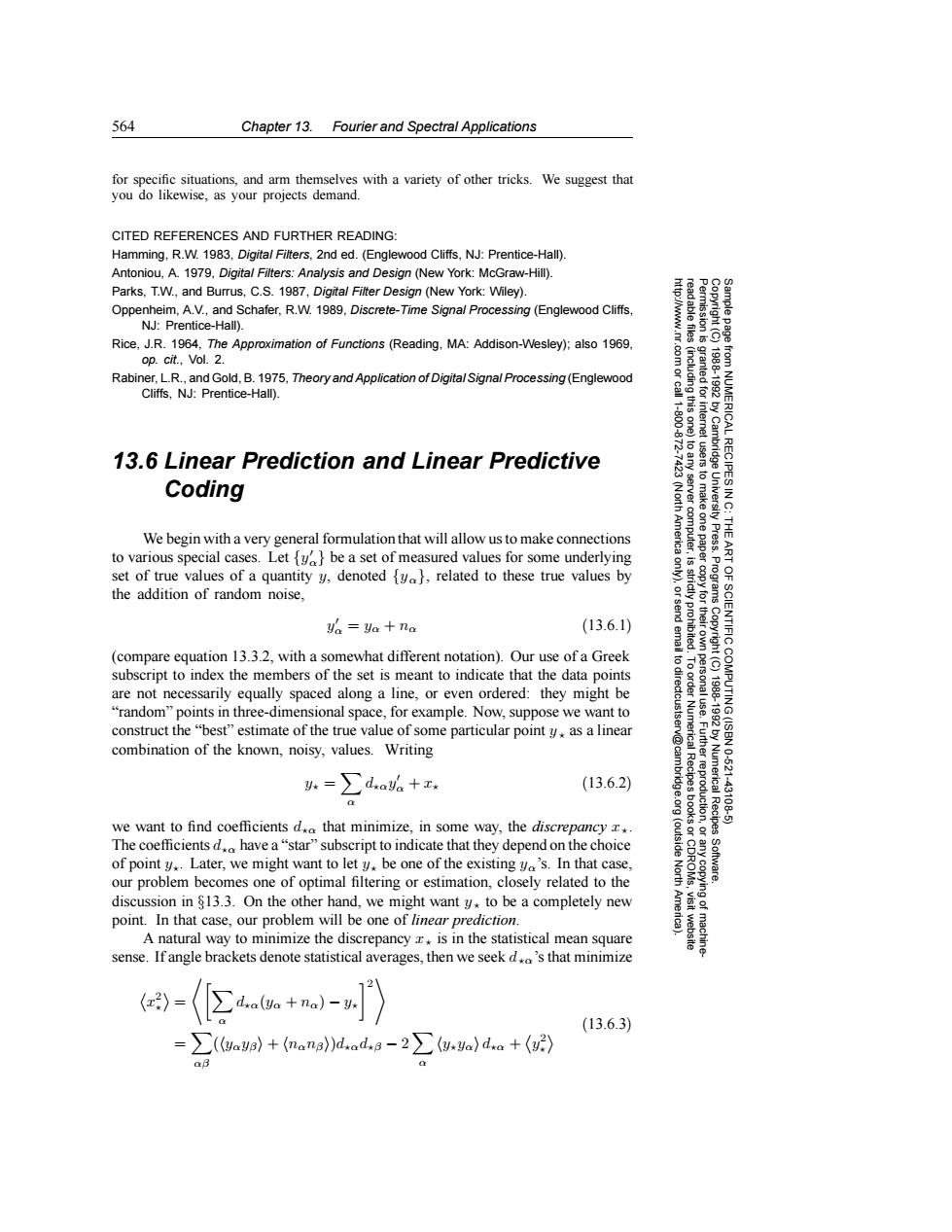正在加载图片...

564 Chapter 13.Fourier and Spectral Applications for specific situations,and arm themselves with a variety of other tricks.We suggest that you do likewise,as your projects demand. CITED REFERENCES AND FURTHER READING: Hamming,R.W.1983,Digita/Filters,2nd ed.(Englewood Cliffs,NJ:Prentice-Hall). Antoniou,A.1979,Digital Filters:Analysis and Design (New York:McGraw-Hill). Parks,T.W.,and Burrus,C.S.1987,Digital Filter Design(New York:Wiley). Oppenheim,A.V.,and Schafer,R.W.1989,Discrete-Time Signa/Processing (Englewood Cliffs, NJ:Prentice-Hall). Rice,J.R.1964.The Approximation of Functions (Reading,MA:Addison-Wesley):also 1969. op.cit.,Vol.2. Rabiner,L.R.,and Gold,B.1975,Theory and Application of DigitalSignal Processing(Englewood Cliffs,NJ:Prentice-Hall). 13.6 Linear Prediction and Linear Predictive Coding (Nort server We begin with a very general formulation that will allow us to make connections America Press. to various special cases.Let fy be a set of measured values for some underlying ART set of true values of a quantity y,denoted [y,related to these true values by the addition of random noise, Programs Ya Ya na (13.6.1) (compare equation 13.3.2,with a somewhat different notation).Our use of a Greek 6 家 subscript to index the members of the set is meant to indicate that the data points are not necessarily equally spaced along a line,or even ordered:they might be "random"points in three-dimensional space,for example.Now,suppose we want to construct the "best estimate of the true value of some particular point y,as a linear combination of the known,noisy,values.Writing =∑d.a%+x (13.6.2) Numerical Recipes 10.621 43106 we want to find coefficients d that minimize,in some way,the discrepancy x.. The coefficients d have a"star"subscript to indicate that they depend on the choice (outside of point y..Later,we might want to let y,be one of the existing y's.In that case our problem becomes one of optimal filtering or estimation,closely related to the North Software. discussion in $13.3.On the other hand,we might want y.to be a completely new point.In that case,our problem will be one of linear prediction. A natural way to minimize the discrepancy r.is in the statistical mean square sense.If angle brackets denote statistical averages,then we seek d's that minimize (13.6.3) =(aa)+(nana)d.ad,g-2(:ya)da+(g〉564 Chapter 13. Fourier and Spectral Applications Permission is granted for internet users to make one paper copy for their own personal use. Further reproduction, or any copyin Copyright (C) 1988-1992 by Cambridge University Press. Programs Copyright (C) 1988-1992 by Numerical Recipes Software. Sample page from NUMERICAL RECIPES IN C: THE ART OF SCIENTIFIC COMPUTING (ISBN 0-521-43108-5) g of machinereadable files (including this one) to any server computer, is strictly prohibited. To order Numerical Recipes books or CDROMs, visit website http://www.nr.com or call 1-800-872-7423 (North America only), or send email to directcustserv@cambridge.org (outside North America). for specific situations, and arm themselves with a variety of other tricks. We suggest that you do likewise, as your projects demand. CITED REFERENCES AND FURTHER READING: Hamming, R.W. 1983, Digital Filters, 2nd ed. (Englewood Cliffs, NJ: Prentice-Hall). Antoniou, A. 1979, Digital Filters: Analysis and Design (New York: McGraw-Hill). Parks, T.W., and Burrus, C.S. 1987, Digital Filter Design (New York: Wiley). Oppenheim, A.V., and Schafer, R.W. 1989, Discrete-Time Signal Processing (Englewood Cliffs, NJ: Prentice-Hall). Rice, J.R. 1964, The Approximation of Functions (Reading, MA: Addison-Wesley); also 1969, op. cit., Vol. 2. Rabiner, L.R., and Gold, B. 1975, Theory and Application of Digital Signal Processing (Englewood Cliffs, NJ: Prentice-Hall). 13.6 Linear Prediction and Linear Predictive Coding We begin with a very general formulation that will allow us to make connections to various special cases. Let {y α} be a set of measured values for some underlying set of true values of a quantity y, denoted {yα}, related to these true values by the addition of random noise, y α = yα + nα (13.6.1) (compare equation 13.3.2, with a somewhat different notation). Our use of a Greek subscript to index the members of the set is meant to indicate that the data points are not necessarily equally spaced along a line, or even ordered: they might be “random” points in three-dimensional space, for example. Now, suppose we want to construct the “best” estimate of the true value of some particular point y as a linear combination of the known, noisy, values. Writing y = α dαy α + x (13.6.2) we want to find coefficients dα that minimize, in some way, the discrepancy x. The coefficients dα have a “star” subscript to indicate that they depend on the choice of point y. Later, we might want to let y be one of the existing yα’s. In that case, our problem becomes one of optimal filtering or estimation, closely related to the discussion in §13.3. On the other hand, we might want y to be a completely new point. In that case, our problem will be one of linear prediction. A natural way to minimize the discrepancy x is in the statistical mean square sense. If angle brackets denote statistical averages, then we seek dα’s that minimize x2 = α dα(yα + nα) − y 2 = αβ (yαyβ + nαnβ)dαdβ − 2 α yyα dα + y2 (13.6.3)������������������������